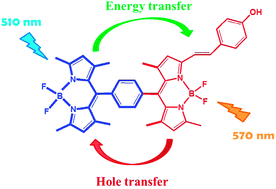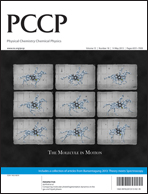Photoinduced energy and charge transfer in a p-phenylene-linked dyad of boron dipyrromethene and monostyryl boron dipyrromethene†
Abstract
Boron dipyrromethenes (BDPs) are excellent building blocks for design of artificial light harvesting and charge separation systems. In the present work, we report the results of photophysical studies of a novel dyad, in which a BDP and a mono-styryl BDP (MSBDP) are covalently linked to each other at the meso-position via a p-phenylene unit. It was found that the photophysical properties of the dyad dissolved in polar as well as nonpolar solvents are strongly affected by two different types of interactions between the BDP and MSBDP parts, namely excitation energy transfer and photoinduced electron transfer. The first process delivers the excitation energy to the first excited singlet state of the MSBDP-part upon excitation of the BDP unit. The direct or indirect (via excitation energy transfer) population of the first excited singlet state of the MSBDP moiety is followed by hole transfer to generate the charge-separated state. In non-polar toluene, the probability of charge separation is low, whereas in polar acetonitrile the charge separation quantum yield is close to unity, resulting in strong quenching of the MSBDP fluorescence.


 Please wait while we load your content...
Please wait while we load your content...